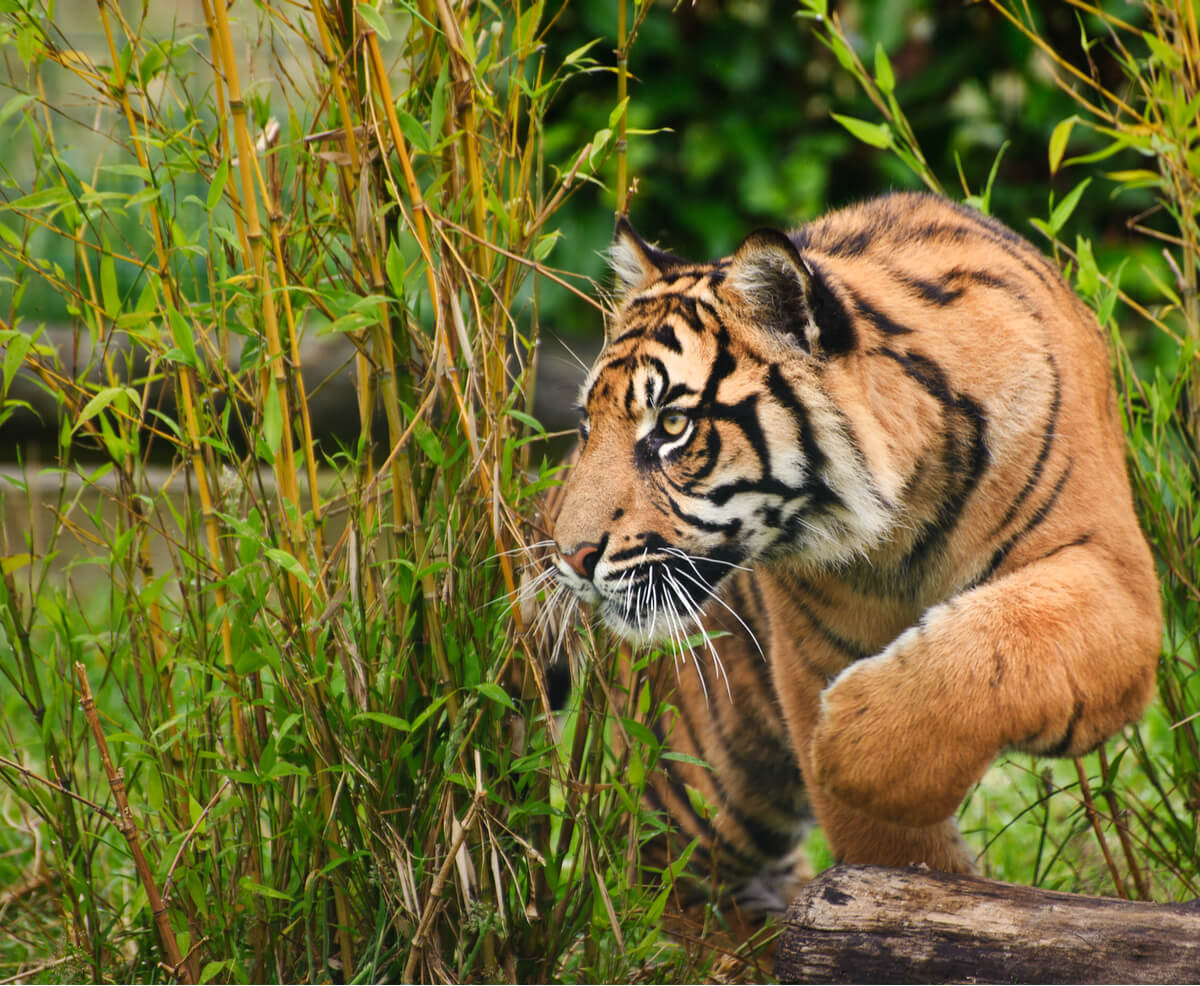Characteristics of the Sumatran Tiger


Written and verified by the biologist Miguel Mata Gallego
The Sumatran tiger is one of the world’s most endangered felines. Habitat loss is the main threat to this beautiful, majestic animal, even though it’s highly protected. In addition, this tiger has its own characteristics that make it unique and distinguish it from the rest of the felids that inhabit the Earth.
How does this feline live? What distinguishes it from other tigers? Why is it in danger of extinction? We’ll tell you all this and much more in the following article.
Habitat and way of life of the Sumatran tiger
Deep in the jungles of the Indonesian island of Sumatra, lives a terrible predator that’s at the top of the food chain. Once abundant throughout the lands of this huge tropical island, its habitat has been greatly reduced by human intervention.
Unfortunately, the Sumatran tiger (Panthera tigris sumatrae) is a critically endangered (CR) animal, according to the International Union for Conservation of Nature (IUCN).
It’s estimated that around 400 to 500 individuals inhabit Indonesian national parks, from the lowland jungle of Bukit Barisan Selatan National Park to the mountainous forests of Gunung Leuser National Park.
In these places, despite environmental protection, jungle destruction is a reality. Apart from the loss of the jungle, it’s estimated that around 66 tigers were killed by poachers in the 2000s, so human hunting poses a major threat to this feline.

Characteristics of the Sumatran tiger
The most relevant thing about this subspecies of tiger is that it has its own characteristics that differentiate it from mainland tigers. Among them, we find the following:
- Sumatran tigers are the smallest subspecies of tiger in existence. This allows them to move more easily through the dense jungle that constitutes their habitat.
- Their characteristic vertical stripes are somewhat more abundant and thinner than those of continental tigers.
- Their beards are more developed than those of other tigers. This difference is especially noticeable in males.
- Despite all this, probably their most distinctive feature is the presence of a membrane between the toes. This membrane makes them excellent swimmers, an ability they use to drive their terrestrial prey into the water.
- In terms of weight and measurements, males measure an average of 2.30 meters (7.5 feet) from head to tail and weigh about 120 kilograms (265 pounds). Females, on the other hand, measure 2.20 meters (7.2 feet) and weigh around 90 kilograms (200 pounds) on average.
All these distinctive features are the consequence of an adaptation process that, albeit slow, is still taking place today. Because the Sumatran tiger lives on an island – isolated from other tigers – it’s easily differentiated from other continental species.
Lifestyle and diet
The Sumatran tiger is, above all, a carnivorous animal. These felines are solitary predators, hunting at night and stalking their prey with great stealth before finally attacking them from behind or the sides. Their keen sense of hearing and powerful eyesight make them fearsome predators.
Like other felines, they have a habit of marking their territory by scratching and scent marking. This serves to ensure that they’ll have no competitors, although females can come and go without any problem.
Their preferred prey are usually wild boar and deer, but sometimes they also hunt birds, fish, or even larger and more lethal animals, such as crocodiles or rhinoceroses. Nothing escapes the claws of this feline!
Reproduction
The Sumatran tiger is able to reproduce at any time of the year. Their gestation period lasts about 103 days, after which they give birth to a litter of 2 to 4 cubs. These young are raised in burrows, but they don’t come out of them until they are one month old. After that, they’ll spend their first two years with their mothers before becoming independent and beginning their solitary life.
Conservation of the Sumatran tiger
The unique characteristics of this subspecies – and the fact that it’s highly endangered in its natural environment – make this feline a priority in conservation programs.
The Sumatran tiger is the only living representative of the tiger subspecies that once inhabited the Indonesian islands, such as the Javan or Bali tiger. For this reason – and because the Sumatran tiger is considered to be on the verge of becoming a new species – the conservation of this feline is important.
The island of Sumatra is suffering from a very serious deforestation process, in order to obtain sugar, rubber and palm oil plantations. As a consequence, Sumatran tigers are losing their habitat, so their population is in clear decline according to the latest data, which show a 40% loss of tigers in the last 40 years.
Tigers need a home range of many square kilometers of jungle to survive, which today is only possible in national parks
.

As you may have noticed, the Sumatran tiger is a subspecies of tiger with unique characteristics and very threatened by the destruction of the jungle, so it simply must be the subject of conservation programs. We can’t afford to lose any more biodiversity.
The Sumatran tiger is one of the world’s most endangered felines. Habitat loss is the main threat to this beautiful, majestic animal, even though it’s highly protected. In addition, this tiger has its own characteristics that make it unique and distinguish it from the rest of the felids that inhabit the Earth.
How does this feline live? What distinguishes it from other tigers? Why is it in danger of extinction? We’ll tell you all this and much more in the following article.
Habitat and way of life of the Sumatran tiger
Deep in the jungles of the Indonesian island of Sumatra, lives a terrible predator that’s at the top of the food chain. Once abundant throughout the lands of this huge tropical island, its habitat has been greatly reduced by human intervention.
Unfortunately, the Sumatran tiger (Panthera tigris sumatrae) is a critically endangered (CR) animal, according to the International Union for Conservation of Nature (IUCN).
It’s estimated that around 400 to 500 individuals inhabit Indonesian national parks, from the lowland jungle of Bukit Barisan Selatan National Park to the mountainous forests of Gunung Leuser National Park.
In these places, despite environmental protection, jungle destruction is a reality. Apart from the loss of the jungle, it’s estimated that around 66 tigers were killed by poachers in the 2000s, so human hunting poses a major threat to this feline.

Characteristics of the Sumatran tiger
The most relevant thing about this subspecies of tiger is that it has its own characteristics that differentiate it from mainland tigers. Among them, we find the following:
- Sumatran tigers are the smallest subspecies of tiger in existence. This allows them to move more easily through the dense jungle that constitutes their habitat.
- Their characteristic vertical stripes are somewhat more abundant and thinner than those of continental tigers.
- Their beards are more developed than those of other tigers. This difference is especially noticeable in males.
- Despite all this, probably their most distinctive feature is the presence of a membrane between the toes. This membrane makes them excellent swimmers, an ability they use to drive their terrestrial prey into the water.
- In terms of weight and measurements, males measure an average of 2.30 meters (7.5 feet) from head to tail and weigh about 120 kilograms (265 pounds). Females, on the other hand, measure 2.20 meters (7.2 feet) and weigh around 90 kilograms (200 pounds) on average.
All these distinctive features are the consequence of an adaptation process that, albeit slow, is still taking place today. Because the Sumatran tiger lives on an island – isolated from other tigers – it’s easily differentiated from other continental species.
Lifestyle and diet
The Sumatran tiger is, above all, a carnivorous animal. These felines are solitary predators, hunting at night and stalking their prey with great stealth before finally attacking them from behind or the sides. Their keen sense of hearing and powerful eyesight make them fearsome predators.
Like other felines, they have a habit of marking their territory by scratching and scent marking. This serves to ensure that they’ll have no competitors, although females can come and go without any problem.
Their preferred prey are usually wild boar and deer, but sometimes they also hunt birds, fish, or even larger and more lethal animals, such as crocodiles or rhinoceroses. Nothing escapes the claws of this feline!
Reproduction
The Sumatran tiger is able to reproduce at any time of the year. Their gestation period lasts about 103 days, after which they give birth to a litter of 2 to 4 cubs. These young are raised in burrows, but they don’t come out of them until they are one month old. After that, they’ll spend their first two years with their mothers before becoming independent and beginning their solitary life.
Conservation of the Sumatran tiger
The unique characteristics of this subspecies – and the fact that it’s highly endangered in its natural environment – make this feline a priority in conservation programs.
The Sumatran tiger is the only living representative of the tiger subspecies that once inhabited the Indonesian islands, such as the Javan or Bali tiger. For this reason – and because the Sumatran tiger is considered to be on the verge of becoming a new species – the conservation of this feline is important.
The island of Sumatra is suffering from a very serious deforestation process, in order to obtain sugar, rubber and palm oil plantations. As a consequence, Sumatran tigers are losing their habitat, so their population is in clear decline according to the latest data, which show a 40% loss of tigers in the last 40 years.
Tigers need a home range of many square kilometers of jungle to survive, which today is only possible in national parks
.

As you may have noticed, the Sumatran tiger is a subspecies of tiger with unique characteristics and very threatened by the destruction of the jungle, so it simply must be the subject of conservation programs. We can’t afford to lose any more biodiversity.
All cited sources were thoroughly reviewed by our team to ensure their quality, reliability, currency, and validity. The bibliography of this article was considered reliable and of academic or scientific accuracy.
- Linkie, M. (2008, 30 junio). The IUCN Red List – Sumatran Tiger. IUCN Red List of Threatened Species. https://www.iucnredlist.org/species/15966/5334836
- Wibisono, H. T., & Pusparini, W. (2010). Sumatran tiger (Panthera tigris sumatrae): A review of conservation status. Integrative Zoology, 5(4), 313-323.
- Esmeralda, P. M. (2004). Manual de crianza artificial del tigre de bengala (Panthera tigris tigris) en el Zoológico Guadalajara.
This text is provided for informational purposes only and does not replace consultation with a professional. If in doubt, consult your specialist.








